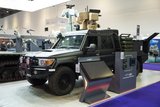JTRS HMS completes formal testing
General Dynamics C4 Systems’ (GDC4S’) JTRS HMS AN/PRC-154 Rifleman radio has completed Initial Operational Test and Evaluation (IOT&E). This is the last formal test required by the military before the radios enter full-rate production, according to a GDC4S 14 December 2011 company statement.
The IOT&E took place during the US Army's recently concluded Network Integration Evaluation at Fort Bliss, Texas. Members of the 2nd Brigade, 1st Armored Division (2/1 AD) evaluated the AN/PRC-154 Rifleman radio in a variety of tactical exercises that included convoy operations, reconnaissance, counterinsurgency and medical evacuation missions.
The Rifleman radio, one of the Joint Tactical Radio System (JTRS) Handheld, Manpack, Small Form Fit (HMS) family of radios, is the first JTRS radio to use the Soldier Radio Waveform (SRW) to enable secure networked communications among platoon, squad and team-level soldiers and their leaders.
Benefits of the new system include the ability for soldiers to communicate with radios instead of shouting or using hand-and-arm signals, which will alter soldiers' tactical approach to missions.
In June 2011, the JTRS HMS program achieved a Milestone C decision, enabling the Low Rate Initial Production of 6,250 AN/PRC-154 Rifleman and 100 AN/PRC-155 Manpack radios. JTRS HMS radios take full advantage of the government's library of waveforms, including the Soldier Radio Waveform, and in the future, the Mobile User Objective System (MUOS) and Wideband Networking Waveform (WNW) critical to communicating on the Army's emerging tactical communications network.
More from Digital Battlespace
-
![Babcock nears first customer for Nomad AI translation tool]()
Babcock nears first customer for Nomad AI translation tool
Nomad can provide militaries with real-time intelligence, saving critical time on the battlefield.
-
![AUSA 2025: Israel’s Asio Technologies to supply hundreds of improved Taurus tactical systems]()
AUSA 2025: Israel’s Asio Technologies to supply hundreds of improved Taurus tactical systems
Taurus operates alongside the Israel Defense Forces’ Orion system which supports mission management across tens of thousands of manoeuvring forces, from squad leaders to battalion commanders.
-
![AUSA 2025: Kopin pushes micro-LED plans as China moves faster]()
AUSA 2025: Kopin pushes micro-LED plans as China moves faster
The plan for the new displays follows fresh investment in Kopin’s European facilities by Theon and an order for head-up displays in fielded aircraft, with funding from the US Department of Defense.
-
![AUSA 2025: Persistent Systems to complete its largest order by year’s end]()
AUSA 2025: Persistent Systems to complete its largest order by year’s end
Persistent Systems received its largest ever single order for its MPU5 devices and other systems earlier this month and has already delivered the 50 units to the US Army’s 4th Infantry Division.
-
![Aselsan brings in dozens of companies and systems under the Steel Dome umbrella]()
Aselsan brings in dozens of companies and systems under the Steel Dome umbrella
Turkey has joined the family of countries attempting to establish a multilayered air defence system with government approval in August 2024 for the effort landed by Aselsan. Dubbed Steel Dome, the programme joins Israel’s Iron Dome, the US Golden Dome, India’s Mission Sudarshan Chakra and South Korea’s low-altitude missile defence system.
-
![DSEI 2025: MARSS unveils new agnostic multidomain C4 system]()
DSEI 2025: MARSS unveils new agnostic multidomain C4 system
MARSS’ NiDAR system has been deployed using sensors from static platforms to provide detection and protection for static sights, such as critical infrastructure, ports and military bases.




























